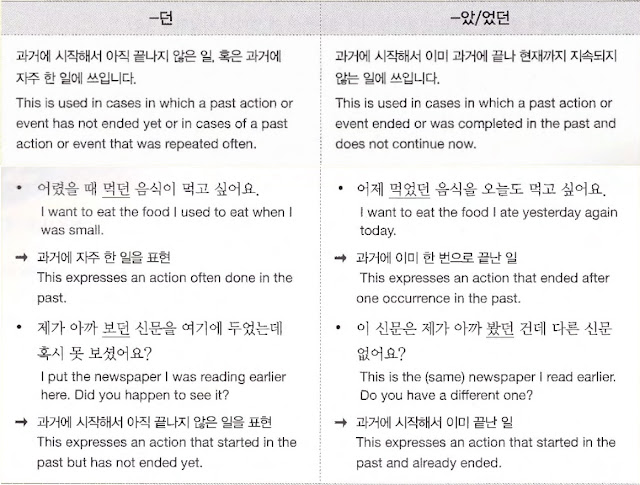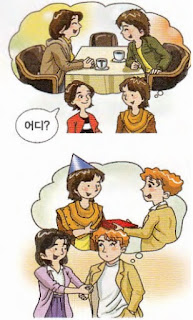가: 어디에서 만날까요?
Where shall we meet?
나: 지난번에 만났던 커피숍에서 만나요.
Let’s meet at that coffee shop where we met last time.
가: 이 옷 멋있네요. 새로 사셨어요?
Those are nice clothes. Are they new?
나: 아키라 씨 생일 파티 때 입었던 옷인데 기억 안 나세요?
These are the clothes I wore to Akira’s birthday party. You don’t remember them?
This expression is used when recalling a past event or state of affairs that has not continued to the present, it consists of -았/었- indicating completion, and 던, indicating recollection, and is used before nouns.

• 어렸을 때 암전했던 윤주가 지금은 적극적인 성격으로 바뀌었어요.
Yunju, who used to be modest when she was young, now has an aggressive personality.
• 어제 점심 때 먹었던 음식 이름이 뭐지요?
What is the name of that food we had for lunch yesterday?
• 작년 여름에 놀러 갔던 곳에 다시 가고 싶어요.
I want to go back to that place we went to last summer.
See Chapter: -던 Expressing Recollection here.
1. For adjectives and some verbs that express a certain degree of a continued state such as ‘살다’, ‘근무하다’, ‘다니다’, ‘사귀다’ the expression -았/었던 can be replaced with -던 without a change in meaning.
• 이 집은 제가 어렸을 때 살았던 집입니다.
= 이 집은 제가 어렸을 때 살던 집입니다.
This is the house I lived in growing up.
• 고등학교 때 뚱뚱했던 유진이는 대학교에 와서 살을 많이 빼 날씬해졌습니다.
= 고등학교 때 뚱뚱하던 유진이는 대학교에 와서 살을 많이 빼 날씬해졌습니다.
Yujin, who was chubby in high school, went to college and became thin after losing a lot of weight.
2. Unlike the case with verbs, when -았/었던 is attached to adjectives there are two possible interpretations. It can refer to cases in which the present situation has become the opposite or contrary to a past situation or state of affairs, or it can refer to cases in which a past situation has continued in the same state until the present.
• 초등학교 때는 키가 작았던 도영이가 지금은 패션모델을 할 정도로 컸대요.
Doyeong, who used to be short during elementary school, is now so tall she could be a fashion model.
The past and present situations are contrastive.
• 어릴 때부터 똑똑했던 경수는 대학교에 가서도 항상 1등을 한대요.
Gyeongsu, who was always bright as a kid, is always first in his class (even now) in college.
The past situation continues to the present.
1. While -던 and -았/었던 are similar forms, they have the following differences.

2. The phrase -(으)ㄴ can refer either to the fact that some action or event simply happened in the past or to the fact that the completed state of an action or event has continued to the present. Thus, it differs from -았/었던 in the following ways.
 3. When expressing the past with verbs, both -(으)ㄴ and -던 can be used, but in the case of adjectives, 이다 and 아니다 the expression -았/었던 must be used. However, -던 can also be used in place of -았/었던 with no change in meaning.
3. When expressing the past with verbs, both -(으)ㄴ and -던 can be used, but in the case of adjectives, 이다 and 아니다 the expression -았/었던 must be used. However, -던 can also be used in place of -았/었던 with no change in meaning.
• 10년 전에 중학생인 수경이가 이제 결혼하여 애 엄마가 되었어요. (X)
->10년 전에 중학생이었던 수경이가 이제 결혼하여 애 엄마가 되었어요. (〇)
->10년 전에 중학생이던 수경이가 이제 결혼하여 애 엄마가 되었어요. (〇)
Sugyeong, who was a middle school student (only) 10 years ago, has now gotten married and become a mother.
• 어렸을 때 조용한 주영이는 고등학교에 들어가면서 활발한 아이로 변했어요. (X)
->어렸을 때 조용했던 주영이는 고등학교에 들어가면서 활발한 아이로 변했어요. (O)
->어렸을 때 조용하던 주영이는 고등학교에 들어가면서 활발한 아이로 변했어요. (O)
Juyeong, who was quiet as a child, has become a lively kid since entering high school.
>> Full of Intermediate grammar: Click here


mantap